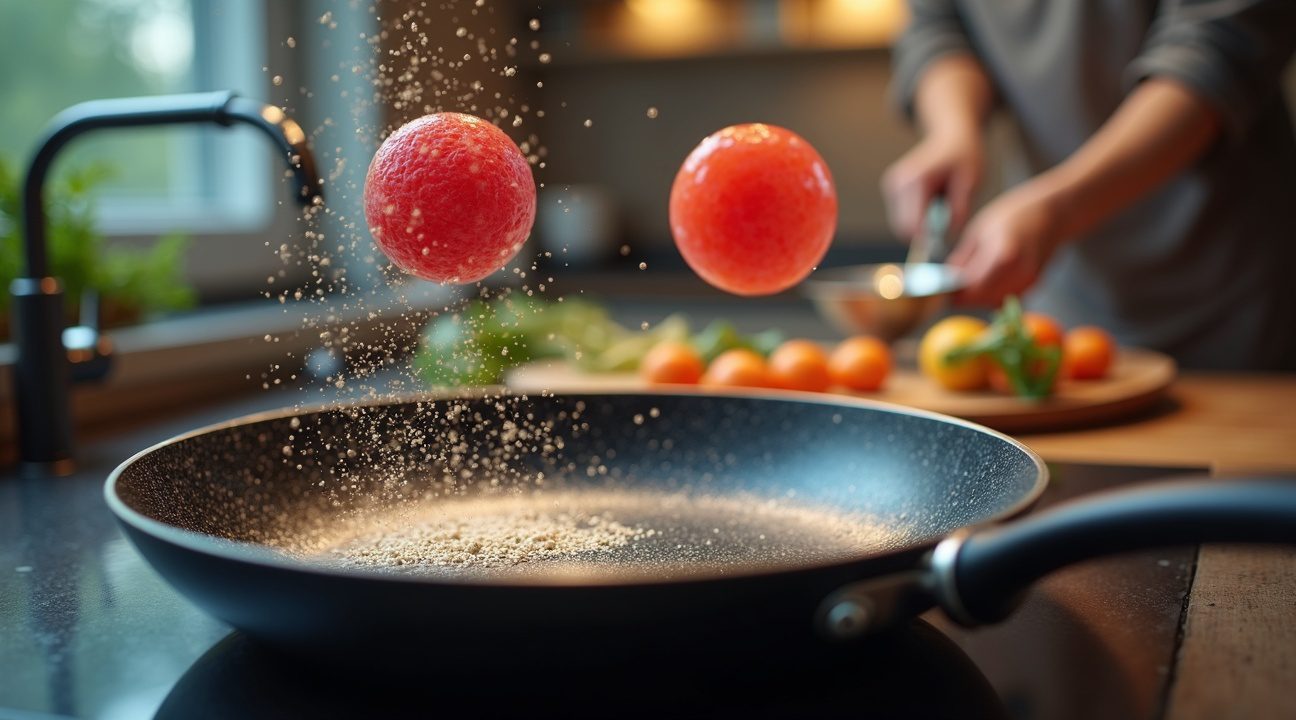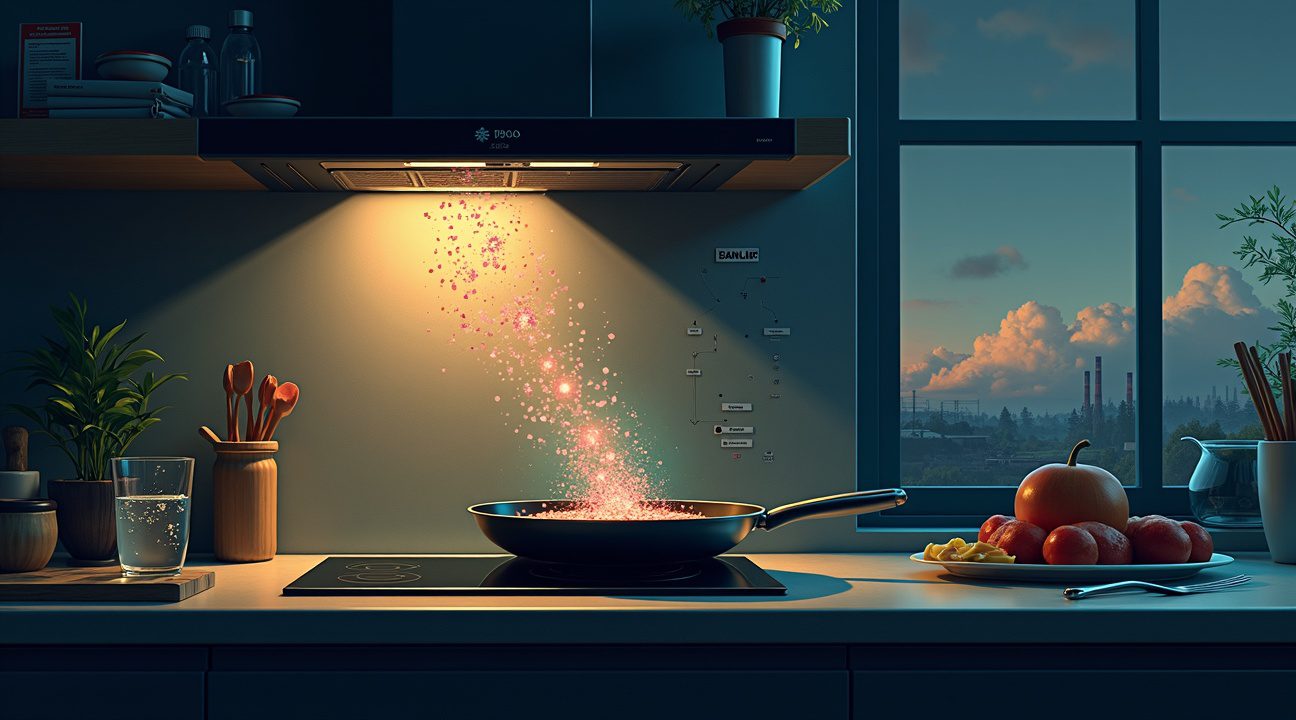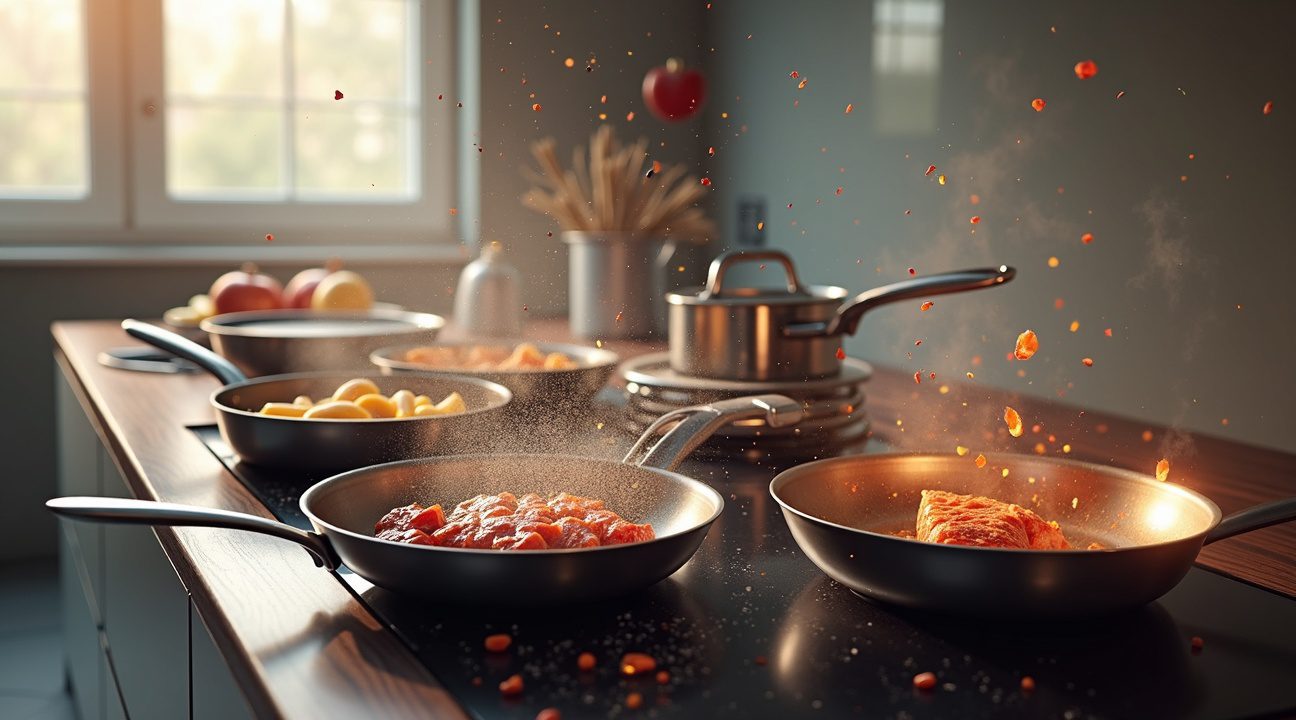A single scratch on a nonstick pan can release up to 9,100 toxic microplastic and nanoplastic particles into your food, with heavily damaged cookware shedding up to 2.3 million particles during just one cooking session.
Key Takeaways
- Even small scratches matter: Minor abrasions on nonstick cookware can release thousands of microplastic particles during a single use. Nanoplastics are especially dangerous, as they are small enough to infiltrate blood cells and reach brain tissue.
- PFAS “forever chemicals” are a major concern: These persistent chemicals found in nonstick coatings stay in both the environment and the human body indefinitely. PFAS exposure is linked to serious health outcomes, including kidney and testicular cancer, liver damage, and reproductive disorders.
- Plastic cutting boards are another source: Cutting on plastic boards releases between 100 and 300 particles per millimeter. Severely worn boards can release up to 3,000 particles per square millimeter.
- Utensil choice does not eliminate risk: Even utensils labeled as “safe”—like silicone and wooden tools—can contribute to the breakdown of nonstick surfaces, increasing particle release.
- Research is still lacking: Scientists emphasize that major gaps remain in our understanding of microplastic contamination. This means consumers may be unknowingly participating in what some experts describe as an uncontrollable health experiment.
To learn more about the dangers of PFAS and their widespread presence, visit the Environmental Working Group or explore resources from trusted scientific communities focused on consumer health and safety.
A Single Scratch Releases 9,100 Toxic Particles Into Every Meal You Cook
I’ve discovered alarming research revealing that a single scratch on Teflon-coated nonstick cookware releases approximately 9,100 microplastic and nanoplastic particles directly into food. This finding exposes a hidden danger lurking in millions of kitchens worldwide, where damaged nonstick surfaces continuously contaminate meals with microscopic plastic particles.
Massive Particle Release From Damaged Coatings
When Teflon coating becomes broken or fractured, the particle release escalates dramatically. A severely damaged pan can shed up to 2.3 million micro- and nanoplastic particles during a single cooking session. These particles fall into two distinct categories:
- Microplastics: Measuring smaller than 5 millimeters
- Nanoplastics: Smaller than 1 micrometer
The technical name for Teflon coating is polytetrafluoroethylene (PTFE), a synthetic polymer that breaks down into countless microscopic fragments when scratched or damaged. I find it particularly concerning that this particle release occurs during normal cooking and cleaning activities, even when no food or oil is present in the pan. This means every interaction with a scratched nonstick surface potentially generates thousands of plastic particles.
Why Nanoplastics Pose the Greatest Threat
Nanoplastics represent the most dangerous category of particles released from damaged cookware. Their incredibly small size allows them to penetrate blood cells and brain tissue directly, bypassing the body’s natural filtration systems. Unlike larger microplastics that might pass through the digestive system, nanoplastics can cross cellular barriers and accumulate in vital organs.
I’ve learned that these particles don’t just contaminate individual meals – they build up over time with each use of damaged cookware. Every scratch amplifies the contamination level, creating a cumulative exposure effect that increases health risks with prolonged use.
The invisible nature of this contamination makes it particularly insidious. Cooks can’t see the microscopic particles being released, so they continue using damaged pans without realizing they’re adding thousands of plastic fragments to their food. Even minor surface damage that appears cosmetic can trigger significant particle release, making visual inspection an unreliable method for determining cookware safety.
Recent studies have shown that heating damaged nonstick surfaces accelerates particle release rates. High temperatures cause the compromised PTFE coating to break down more rapidly, multiplying the number of particles shed into food. This discovery challenges conventional wisdom about nonstick cookware durability and safety.
I recommend inspecting nonstick pans regularly for any signs of surface damage, including minor scratches, chips, or areas where the coating appears worn. Professional kitchens often replace nonstick cookware more frequently than home cooks, recognizing that damaged surfaces compromise both food quality and safety.
The research indicates that particle release isn’t limited to cooking activities alone. Cleaning damaged nonstick surfaces with abrasive materials or dishwashers can also trigger significant particle shedding. Each cleaning cycle potentially adds more microscopic plastic fragments to the contamination problem.
Alternative cookware materials like stainless steel, cast iron, or ceramic don’t present the same microplastic contamination risks. These options eliminate the possibility of coating breakdown while maintaining excellent cooking performance.
I strongly advise replacing any nonstick cookware showing visible damage immediately. The cost of replacement pales in comparison to the potential health consequences of continued exposure to thousands of plastic particles with each meal prepared in damaged pans.

PFAS Forever Chemicals Are Contaminating Your Kitchen and Your Body
I’ve discovered that the nonstick coating on these pans contains per- and polyfluoroalkyl substances (PFAS), which scientists call “forever chemicals” for a chilling reason. These substances don’t break down naturally in the environment or in human bodies, creating a permanent contamination problem that affects millions of households daily.
Until 2013, Teflon cookware contained PFOA (perfluorooctanoic acid), a chemical that raised serious health concerns among researchers. A major 2013 study revealed a disturbing connection between high PFOA exposure and increased rates of kidney and testicular cancers in exposed populations. This finding prompted manufacturers to phase out PFOA from their products, but the story doesn’t end there.
Modern Teflon now uses newer-generation PFAS compounds, yet some of these replacements have been linked to similar health risks. The problem lies in the fundamental chemistry of these substances – they’re designed to be incredibly stable and resistant to heat, which makes them excellent for nonstick surfaces but terrible for human health.
How Forever Chemicals Accumulate in Your Body
PFAS chemicals persist in the environment indefinitely, earning their ominous nickname through decades of scientific observation. When I scratch a nonstick pan during cooking, those released microplastic particles carry these forever chemicals directly into my food. Once consumed, these chemicals accumulate in my body over time, building up in my blood, liver, and other organs.
The accumulation process happens gradually through multiple exposure sources:
- Contaminated drinking water from industrial discharge
- Food packaging materials containing PFAS
- Household products like stain-resistant carpets and waterproof clothing
- Direct ingestion from scratched nonstick cookware
Scientists have found PFAS in the blood of nearly every American tested, demonstrating how widespread this contamination has become. Unlike other toxins that my body can process and eliminate, forever chemicals remain in my system for years or even decades after exposure.
The health implications extend beyond cancer risks. Research suggests PFAS exposure may:
- Disrupt hormone function
- Weaken immune system response
- Interfere with reproductive health
These chemicals can cross the placental barrier, meaning pregnant women can pass PFAS contamination to their developing children.
I find it particularly concerning that manufacturers knew about these risks for decades before taking action. Internal company documents revealed that chemical companies understood the potential dangers of PFAS as early as the 1970s, yet continued production without adequate warning to consumers.
Each time I use a scratched nonstick pan, I’m potentially adding to my lifetime PFAS burden. The microplastic particles released through normal wear carry concentrated amounts of these forever chemicals directly into my meals. Even minimal scratching can release thousands of particles in a single cooking session, making contamination almost inevitable with regular use.
The persistence of these chemicals means that decisions I make today about cookware will affect my health for decades to come. Switching to alternative cooking surfaces becomes not just a preference but a health necessity when considering the long-term implications of PFAS exposure.
Environmental contamination from PFAS has reached crisis levels, with these chemicals detected in groundwater, soil, and wildlife across the globe. Manufacturing facilities that produced PFAS-containing products have left behind contaminated sites that will require decades and billions of dollars to remediate.
The regulatory response has been slow but is gaining momentum. Several states have begun restricting PFAS use in consumer products, while federal agencies are developing stricter guidelines for acceptable exposure levels. However, the damage from decades of unrestricted use will persist in our environment and our bodies for generations to come.

The Hidden Health Crisis: Cancer, Birth Defects, and Organ Damage
When I examine the research on PFAS exposure, the findings paint a troubling picture of widespread health consequences. These forever chemicals accumulate in the human body over time, creating cascading effects throughout multiple organ systems. Exposure to PFAS has been directly linked to liver disease, chronic kidney disease, and high blood pressure. The cardiovascular implications alone represent a significant public health concern, as these conditions affect millions of people worldwide.
Cancer risks present perhaps the most alarming aspect of PFAS contamination. Scientific studies have established strong connections between these chemicals and both kidney and testicular cancers. The persistent nature of PFAS means that even minimal exposure can contribute to long-term cancer development, making prevention through cookware choices increasingly critical.
The Nanoplastic Threat to Human Biology
Nanoplastics represent an even more insidious danger than their larger counterparts. These microscopic particles possess the unique ability to cross biological barriers that typically protect our organs from foreign substances. I’ve observed how these particles can penetrate the blood-brain barrier, placental barrier, and cellular membranes with alarming ease.
The health implications of nanoplastic exposure include:
- Strong correlations with various forms of cancer
- Increased risk of birth defects in developing fetuses
- Significant fertility problems in both men and women
- Potential neurological damage from brain barrier penetration
- Disruption of hormonal systems throughout the body
Temperature plays a crucial role in amplifying these risks. Research shows that nonstick cookware becomes particularly dangerous when temperatures exceed 350°C (662°F). At these elevated temperatures, the coating begins emitting toxic fumes that can cause immediate respiratory distress and contribute to long-term health problems. Many home cooks unknowingly reach these temperatures during high-heat cooking methods like searing or stir-frying.
I find it particularly concerning that nanoplastics can interfere with reproductive health. Studies indicate that exposure during pregnancy may lead to developmental abnormalities in unborn children. The particles’ ability to cross the placental barrier means that pregnant women face unique risks when using damaged nonstick cookware.
The scientific community continues investigating the full scope of health impacts from these materials. Recent research suggests that even low-level, chronic exposure may contribute to autoimmune disorders and metabolic dysfunction. The accumulative nature of both PFAS and nanoplastics means that repeated exposure from scratched cookware compounds these risks over time.
What makes this situation particularly troubling is how easily preventable many of these exposures are. A simple scratch on a nonstick pan can release thousands of toxic particles into a single meal. When I consider that the average household uses nonstick cookware multiple times per week, the cumulative exposure becomes staggering.
The intersection of PFAS and nanoplastic exposure creates a perfect storm for health complications. While researchers work to understand the complete picture, the existing evidence strongly suggests that minimizing exposure through proper cookware selection and maintenance represents one of the most practical steps individuals can take to protect their health.
Fertility concerns extend beyond pregnancy complications. Both male and female reproductive systems show sensitivity to these chemical exposures. Sperm quality, hormone production, and ovarian function all demonstrate measurable impacts from PFAS and nanoplastic contamination. For couples planning families, the choice of cookware becomes more than a kitchen preference—it becomes a health decision with generational implications.
Your Plastic Cutting Board Is Even Worse Than Your Scratched Pan
While scratched nonstick pans release thousands of microplastic particles, plastic cutting boards present an even more alarming source of contamination in the kitchen. Every single cut made along surface grooves releases between 100 to 300 micro- and nanoplastics per millimeter, creating a continuous stream of particles that directly contact food.
The Scale of Contamination From Plastic Cutting Boards
The damage escalates dramatically with board condition. Severely scratched sections release approximately 3,000 particles per square millimeter with each cut – that’s ten times more than what fresh grooves produce. PE-based plastic boards contribute 1 to 7 microplastics per gram of meat during normal food preparation, but the real contamination occurs during cleanup.
Scraping residual meat off plastic boards generates 70 microplastics per gram of food – a process that happens in most kitchens after every meal preparation. I find this particularly concerning because home cooks often scrape boards vigorously to remove stubborn food residues, unknowingly creating microplastic hotspots on their cutting surfaces.
Different proteins show varying levels of contamination when processed on plastic boards. Chicken processed on these surfaces averaged 100 µm microplastic particles, while fish showed higher contamination at 190 µm particles. The larger particle size in fish suggests that the cutting action required for different protein types affects contamination patterns.
Solutions That Actually Work
The good news is that alternatives exist that eliminate this problem entirely. Bamboo cutting boards and metallic meat grinders resulted in no detectable microplastic contamination during testing. This makes switching to natural materials one of the most effective steps home cooks can take to reduce microplastic exposure.
Washing meat after preparation on plastic boards reduces contamination levels, though it doesn’t fully eliminate the particles. I recommend thorough rinsing under cold running water, but this solution treats the symptom rather than addressing the root cause. Modern kitchen innovations continue to emerge, but sometimes the simplest solutions prove most effective.
The microplastic release from cutting boards compounds with contamination from other kitchen sources. When combined with particles from scratched cookware, the total exposure in a typical kitchen becomes substantial. Each meal preparation session potentially introduces hundreds or thousands of microscopic plastic particles into food, creating a daily accumulation that builds over time.
Professional kitchens have started transitioning away from plastic cutting boards, recognizing both the contamination risk and the superior durability of alternatives. Home cooks can follow this lead by investing in quality bamboo or hardwood cutting boards that actually improve with proper care and maintenance.
The cutting action itself matters significantly. Deep, aggressive cuts through tough proteins create more surface damage and higher particle release than gentle slicing motions. However, even careful cutting techniques can’t prevent contamination once a plastic board develops the inevitable scratches and grooves that come with regular use.
Temperature also plays a role in particle release. Plastic boards used for hot foods or cleaned with hot water show increased microplastic shedding compared to those used exclusively for cold preparation. This suggests that heat accelerates the breakdown of plastic surfaces, making particle release more likely during routine kitchen tasks.
Replacement timing becomes critical for households that continue using plastic cutting boards. Once visible scratches and grooves appear, contamination rates increase exponentially. Rather than replacing plastic boards repeatedly, switching to sustainable alternatives like bamboo offers both environmental and health benefits while providing superior cutting surfaces that last for years with proper maintenance.
Every Cooking Method and Kitchen Tool Makes the Problem Worse
I’ve discovered that virtually every tool and technique used in modern kitchens contributes to microplastic release from nonstick surfaces. Common cooking utensils create significant damage to PTFE coatings, with each contact point becoming a source of contamination.
Stainless steel turners rank among the worst offenders for particle release. BBQ clamps, with their metal surfaces and gripping action, scrape away coating fragments with each use. Steel wool presents an even greater threat, as its abrasive nature strips away substantial amounts of PTFE material during cleaning.
Surprisingly, even supposedly “safe” alternatives cause problems. Silicone whisks, often marketed as cookware-friendly options, still generate particle release when used with brand-new nonstick pans. This finding challenges the assumption that soft materials prevent coating damage. Wooden turners, another popular alternative, also contribute to particle release despite their gentler reputation.
Cooking Methods Amplify the Risk
Different cooking techniques produce varying levels of contamination. Extended frying sessions generate significantly more particles compared to oven baking methods. The combination of direct heat, extended contact time, and utensil interaction creates optimal conditions for coating degradation.
Temperature plays a critical role in particle release intensity. Research shows that heating beyond 350°C dramatically increases the risk of PTFE particle generation. This threshold temperature is easily reached during high-heat cooking methods like searing or stir-frying, making these techniques particularly hazardous for nonstick cookware users.
Both new and aged cookware contribute to the microplastic problem, though older pans in deteriorated condition typically release substantially more particles. Brand-new cookware isn’t immune to this issue, as manufacturing imperfections and initial use patterns establish the foundation for future particle release. The coating’s integrity begins declining from the first use, creating an escalating contamination cycle.
The cumulative effect of these factors means that standard cooking practices transform everyday meal preparation into a source of microplastic exposure. Each stirring motion, temperature spike, and cleaning session adds to the particle count in food. This reality affects millions of home cooks who rely on nonstick surfaces for convenient meal preparation, unaware that their cooking methods actively contribute to coating degradation and subsequent contamination.

Scientists Are Sounding the Alarm About What We Don’t Know
I find it troubling that leading researchers are expressing serious concerns about the gaps in our understanding of microplastic contamination from cookware. Dr. Cheng Fang from the University of Newcastle has stated that the presence of Teflon microparticles in food may pose a significant health risk that warrants further investigation. His warning signals that we’re potentially exposing ourselves to unknown dangers every time we cook with damaged nonstick surfaces.
Professor Youhong Tang of Flinders University emphasizes the need for caution when selecting and using cooking utensils to minimize food contamination. These expert warnings suggest that our current approach to kitchen safety may be dangerously inadequate.
Critical Research Gaps That Should Concern Everyone
The scope of what scientists don’t know about microplastic contamination is staggering. Currently, there’s no research on how plastic serving equipment—such as ladles, pasta forks, or pizza cutters—contributes to microplastic contamination. Even single-use plastic items like cups and cutlery have only been studied in limited ways. This means millions of people are using potentially contaminating tools without any scientific understanding of the risks.
Characterizing micro- and nanoplastics remains technically challenging, which explains why comprehensive safety data doesn’t exist. Australian researchers employed Raman imaging techniques and specialized algorithms to quantify particle release, demonstrating the sophisticated methods required to even detect these particles. Real-world cooking conditions involving food, oil, and water have not been fully studied, leaving us with incomplete pictures of actual contamination levels.
I’ve learned that in 2024, a collaborative study involving Plymouth Marine Laboratory, NORCE Norwegian Research Centre, SALT Lofoten, and the Norwegian Institute for Water Research confirmed many of these findings. This international research effort validates the concerns about our knowledge gaps while highlighting the urgent need for comprehensive studies.
The scientific community’s alarm isn’t just about what they’ve discovered—it’s about what they haven’t been able to study yet. Without understanding how different cooking conditions, utensil materials, and food types interact to create microplastic contamination, consumers are essentially participating in an uncontrolled experiment every time they prepare meals with potentially compromised cookware.
Sources:
Business Insider – Scratches Teflon Nonstick Pan Release Plastic Particles
LADbible – A Single Scratch on a Non-Stick Pan Is Worse Than People Could Imagine
ScienceAlert – One Small Crack on a Teflon Pan Can Release Thousands of Plastic Particles
Fox News – Non-Stick Pans Could Release Millions Microplastic Particles


